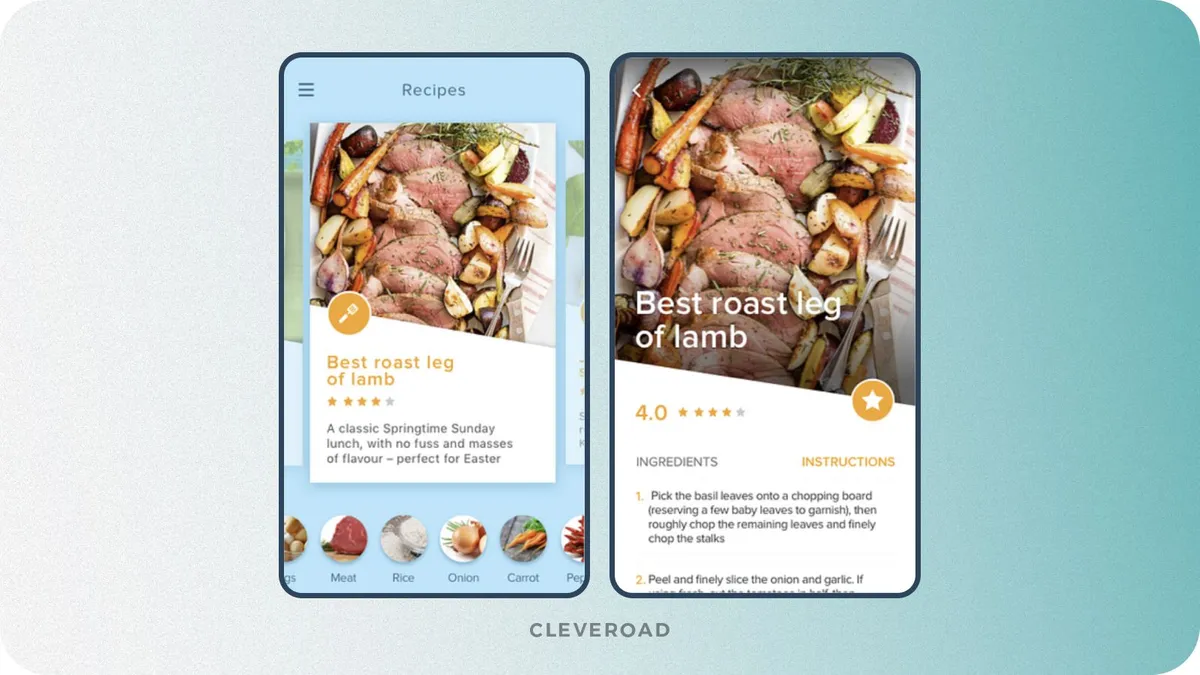How to Make a Nutrition App With No Mistakes [2025 Overview]
Updated 18 Jul 2024
19 Min
10208 Views
So, how to make a nutrition app? Businesses are more rapidly starting to question themselves about this, as the health awareness trend is again going through its peak. As a result, about 50% of users engage with the diet apps at least 3 times a week, moving towards their health goals and healthy diet. This signals high demand and enormous interest. Nutrition tracker app development may help you penetrate the diet app market and present a solution that may be a key to resolving existing industry challenges from the user perspective.
In this article you’ll discover what feature to include into your nutrition tracking app, to how create it, how much does it cost, and how you can benefit from it through monetization.
What Fitness and Nutrition Apps Are All About?
Well, to one it may seem obvious, to another, it could be rather surprising, but the diet and nutrition app can be applied in more than one sphere of life (think sports) and used not only by athletes. Of course, it would be a great companion for those of us who decided to build a perfect body or are preparing for the upcoming sport competition, but food and nutrition tracking tools can be successfully used in medicine and daily life as well.
All the abovesaid means that food trackers can solve numerous tasks usually associated with the usage of a pen and paper, from the daily water intakes logging required when following a postoperative diet to building your grocery shopping list when planning an upcoming dinner with friends. But what do they feel like?
Normally, a food and nutrition tracking app is a tool which helps you log your daily food and liquid intakes, keep track of your activities, count the calories taken/burnt, all this staying away from strict diet. In a word, diet nutrition tracking app development will help your users in taking care of their health. Of course, their stuffing can differ. However, almost all of them have something in common. Considering this fact, we've decided to devote the next two blocks to describing the features that form our food journal app. Are you ready to dive deeper? Suppose you are.
Essential Features for Nutrition App Development
As far as we've touched upon the subject of meal planning app development and their capabilities, you might want to know more about them. If so, we will start with a handful of basic features every self-respectful digital nutritionist should have. We call it the minimum viable product, you can call it 'a normally working application which can attract a good number of users in the beginning'. So let's work on your app idea and build the skeleton of our future food and nutrition app development project by discovering essential app features:
Registration
And our first bone is a registration form. In fact, you shall not pass until the application has the fullest info about your current state. Actually, this move seems quite logical. Because this is typically what you do when you come to a live nutritionist or coach.
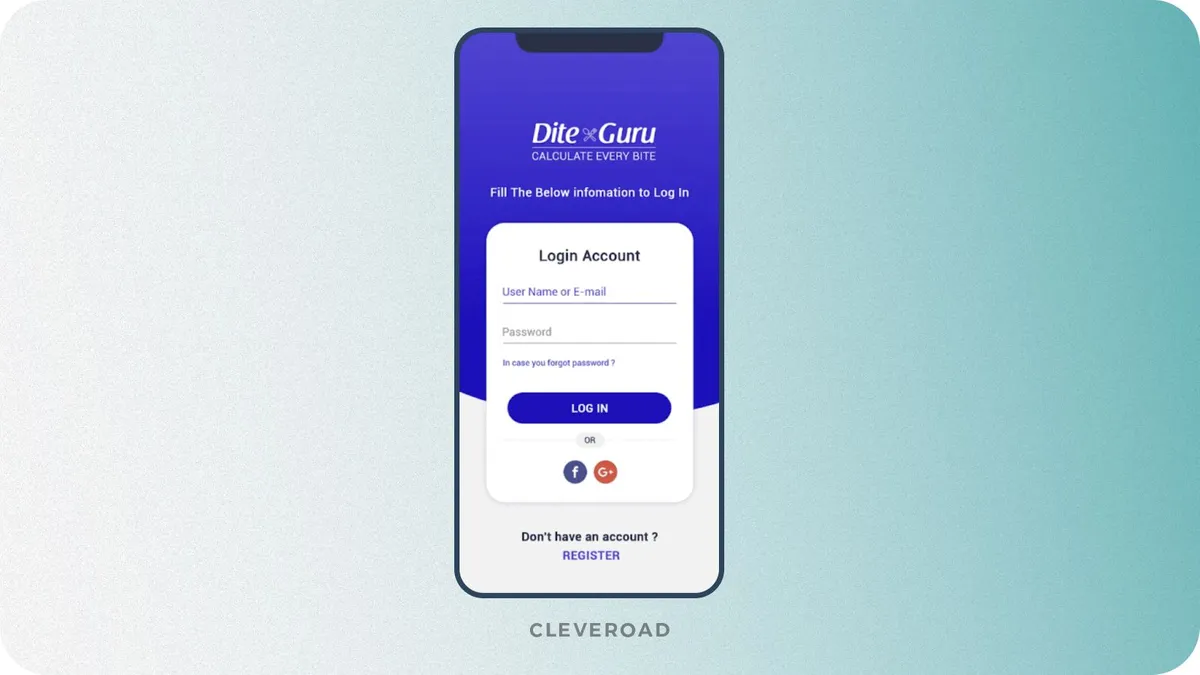
Example of registration screen for diet and nutrition app
However, our in-app registration procedure is a bit different and includes one more action to be performed before giving an exhaustive description of user's physical condition. I mean a standard signing-up via email or social networks. As usual, Twitter, Facebook, Google+, and others are good.
Getting back to the questionnaire, we want to give you a basic idea on what is may contain. Thus, your application can interrogate a user about:
- User's age
- Height
- Current weight
- Desired weight
- Allergies
- Food preferences
- Goals, etc.
Maybe the best but still the most hypercorrect registration form is the one provided by Eat This Much. They have all the abovementioned and two more points like body fat and activity level. Thus, a user can get the best recommendations as for his or her perfect diet.
But what I like even better is their animated tutorial in the very beginning. Actually, an introduction can play a significant role in gaining users' sympathy. That's why we advise you to provide them with a brief explanation on how your food tracking can help them out in solving their problems. Colorful pictures or animations are your best helpers at it.
Note: It's very important to give users an opportunity to choose between the metric and imperial measure units. So you'd better keep it in mind if you want to expand your user base.
Food logging
Let's not forget that the main goal of your diet and nutrition app development is keeping count of what was eaten or drunk. That's why we need some input fields, dictionary, and calories data book. Oh come on, why isn't clear enough?! That's obvious, your users don't want to type the whole name of a dish every time they want to log it. Moreover, counting calories on their own doesn't feel that pretty. So you'd better work out the fullest food dictionary ever and add some colorful pictures to make it look even better. Oh, and take care of a food calories calculator. Let's always learn from the greatest apps to track your food intake (like Ingredient1 or Noom Coach).
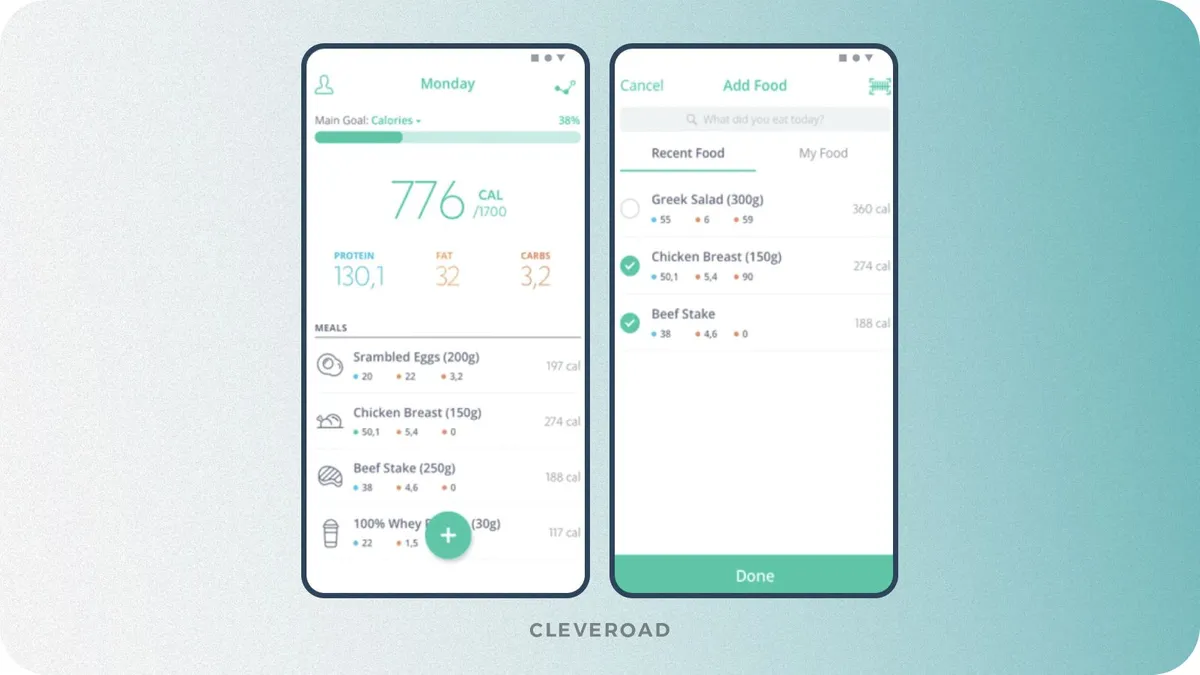
Example of food logging for diet and nutrition app
Dashboard
Actually, these two, I mean the dashboard and food logging, are deeply connected. Once input, daily stats should be visible. A dash of beauty and action is exactly what our application needs. That's why every user's move should be reinforced with a high-level visualization.
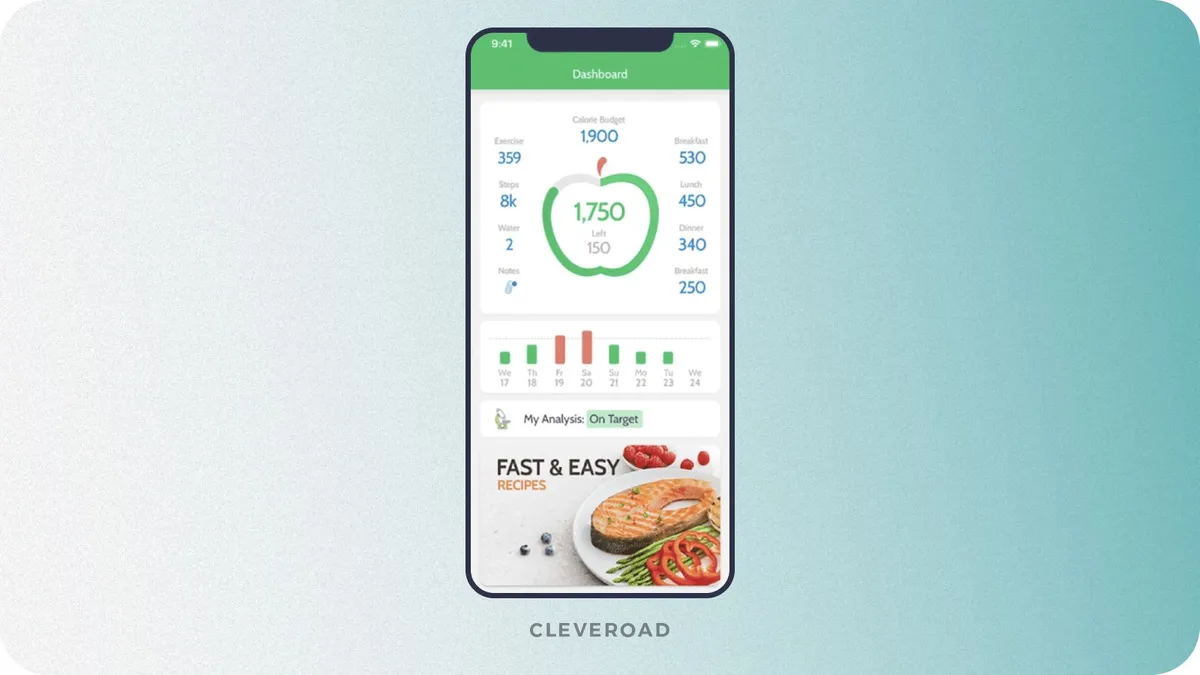
Example of dashboard screen for diet and nutrition app
Diet plan or user's goals
Most users expect your application to provide them with a useful info regarding right eating habits. Ensure your app offers personalized meal plans for everyone.
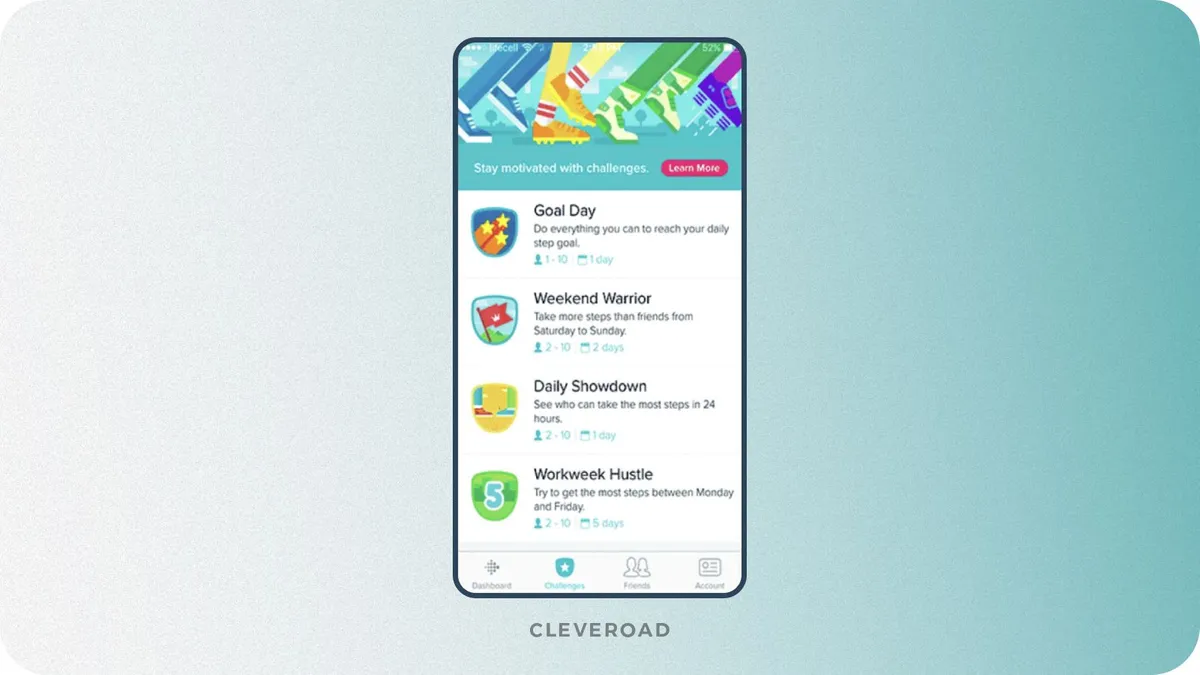
Example of users' goals screen for diet and nutrition app
Once a user specified a goal, desired weight, and food preferences, you may suggest him or her one or another diet. In case you don't want to be responsible for all this stuff, you may redirect them to a real nutritionist. But that's another story (which will be discussed later).
External trackers support
Let your users connect the calorie counting app with third-party devices, and they will be able to track how much calories have been burnt during a day. Apple Watch, Android Wear, Fitbit, and Jawbone are Ok, but our biggest secret is the collaboration with as many wearables and tracking devices as possible. However, we can always steal some data from the Apple's HealthKit and Google Health. Soon you will find out how exactly.
One of the most useful inventions of all times in fitness industry (yet) is the Fitbit Aria smart scale. Why is it smart? Besides the ability to measure user's weight, body fat, heart rate, or monitor the air quality, this device logs this data directly to a smartphone. That's even more convenient than logging via your Apple Watch or Android Wear accessory. One more attractive thing is that this scale supports the logging of multiple family members.
Notifications
To develop a nutrition app that is user-friendly and useful, consider the fact that your meal tracker should be always on the lookout. I mean it can push users toward their goals. And the best way to do it is to remind them of yourself. It would be nice to hear from your app several times a day. However, your tracker shouldn't be annoying. 'Hey, sup?' or 'Get a refresh!' twice a day will be just enough.
Help
Show that your users can always count on you. That's easy, just put the '?' somewhere (in the corner) and let your users refresh their memory in case they are confused with a number of buttons. The introductive tutorial can be not enough sometimes.
Well, at this point, we need to proceed to the following block which includes the features that can be included after your application has grown a significant user base. So let's see how we can add seasoning to your product.
Feel free to contact us. Our team is ready to help you decide on the appropriate feature set to make your nutrition app resolve your users' main pain points.
Additional Features to Include Into Your Nutrition App
These features are special quality-of-life improvements that you can add when MVP features are already implemented. Even though they are not obligatory, you can add them to your diet and nutrition app development features list.
Community
Talk about family members and other people trying to lose weight or live a healthy life together, here should be a social element making them want to return and use your application again and again.
The thing is, people use fitness apps for personal purposes but they do want to show off their results, share experience, and compete. In the case of an app to keep track of weight loss, we could add a food blog, like the best food and nutrition apps do, allowing users to share their favourite recipes and experience. Of course, scoreboards are well accepted. Let your users compete and become healthier two birds with one stone! Check out how it's implemented in MyFitnessPal.
Linking to live experts
However heedful a diet and nutrition application may be, it won't be as severe as a live specialist. So you can integrate something like a real-time chat within your app. Nutrisystem uses such a strategy. The application pairs you with nutrition experts who manages your nutrition on a daily basis. Depending on your goals, a professional works out a diet plan that fits you best and checks if the food you is really healthy. Sounds like another great way to earn money on your app.
We provide top-notch custom software development services to assist you in creating successful, demanded, and profitable digital solutions
Recipes
The in-app recipe book could be actually a good idea for your existing meal planner app. What's more, there is a chance to strengthen this improvement. How? Ask the SideChef mobile app developers. It seems that these guys have just found a new approach to making food. The app provides step-by-step voice instructions while you're completely immersed in cooking (or pan, who knows). If SideChef goes way too fast, you can ask him to repeat commands without having to get your device dirty.
Barcode scanner
To make an adaptive nutrition tracking app and improve your diet application functionality even further, you can integrate a barcode scanning feature . Fooducate has even surpassed itself at it by giving an opportunity to scan item barcodes and get a brief description on how nourishing it is.
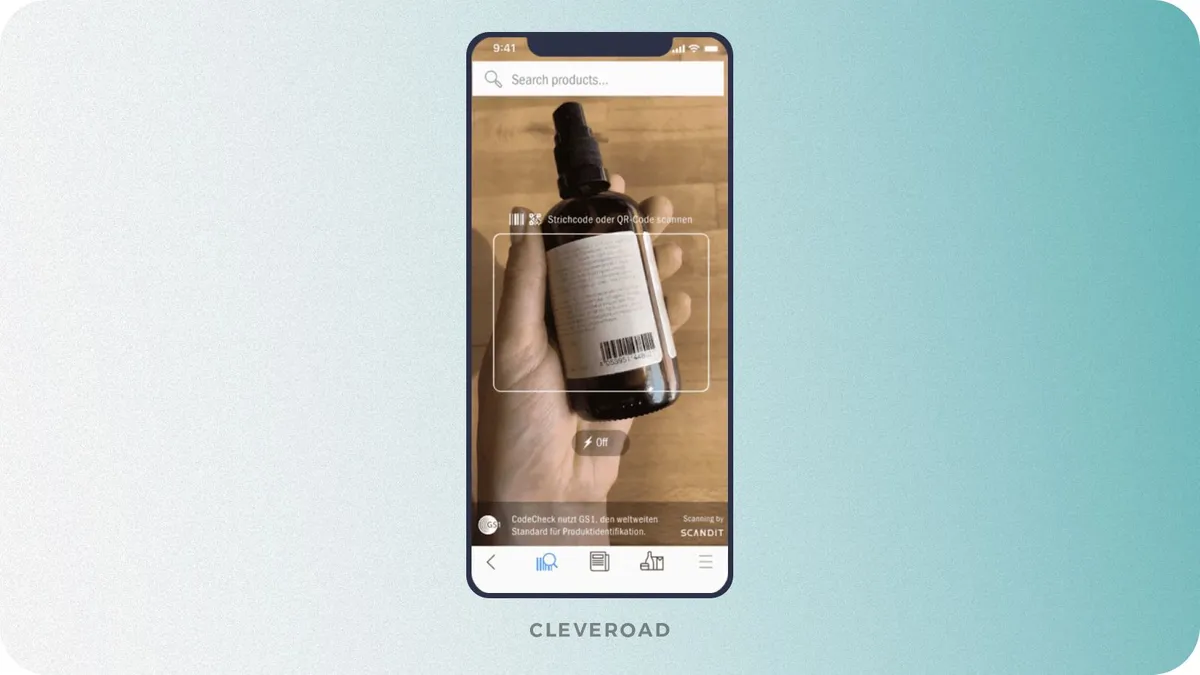
Example of barcode scanning feature for diet and nutrition app
Grocery shopping list
Just like in the case of food logging, you can consider asking your nutrition mobile app development company to embed a dictionary that will help your user out in building grocery shopping lists. Want to stand out? Well, you can learn from Thrive Market and their approach to taking food shopping to the next level. For as little as $59,95 a year, users get the craziest deals on natural and organic products. They even make it possible for a user to shop online and get the order delivered right to his or her door.
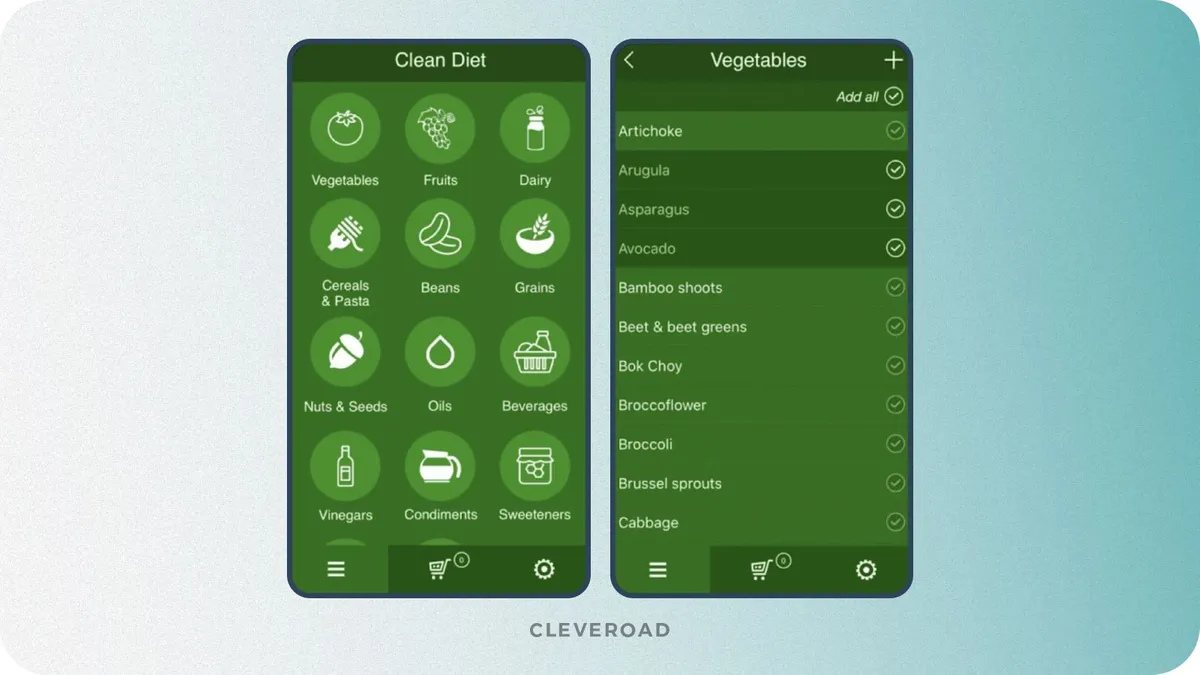
Example of grocery shopping list feature for diet and nutrition app
Special Integrations for Diet Nutrition App Development
Since nutrition apps are quite unusual applications, they cannot be developed without the use of special integrations and tools. Therefore, we decided to highlight the most commonly used APIs in diet and nutrition app development.
HealthKit and Google Health
HealthKit and Google Health are the central repository of health and fitness data on the iOS and Android platforms, respectively. The implementation of these databases is quite useful because with their features, developers can use such functions as:
- Collection and storage of health and fitness data
- Data analysis and visualization
- Enabling social interactions
Apple Watch and Android Wear extension
Apple's and Google's wearables were actually developed to collaborate with mobile applications and be their deputies if a user cannot carry a smartphone around. In addition to transferring features from mobile meal tracking applications, diet and nutrition app development for wearable devices can have unique features, such as a counter of steps, heart rate, calories burned and much more.
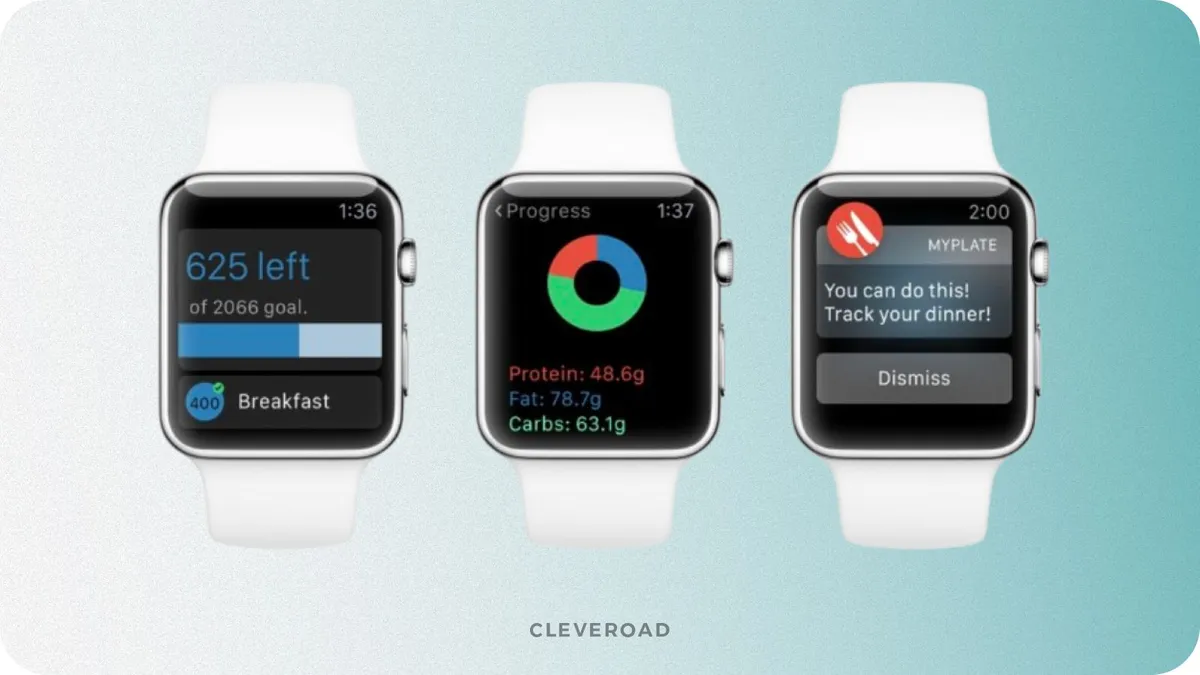
Diet app Apple Watch integration example
Nutritionix
Apple's and Google's wearables were actually developed to collaborate with mobile applications and be their deputies if a user cannot carry a smartphone around. In addition to transferring features from mobile applications, versions for watches can have unique features for this kind of devices, such as a counter of steps, heart rate, calories burned and much more.
Recipe search and diet API
This tool allows you to search a large database of over 2 million recipes. It has an automated nutrition analysis on the web-powered proprietary Natural Language by Processing (NLP) engine.
How to Make a Nutrition App: Step-By-Step Process
After you have drawn up a list of features that you want to implement into your application, it's time to start developing. Since we are an outsourcing company specializing in mobile app development services, we’ll describe the relevant pipeline. If you go to freelancers or create your own team, the diet and nutrition app development process may look different. Besides, keep in mind that the development of a diet app requires careful planning.
So, here's the step-by-step guide on developing a diet app:
Step 1. First contact
The initial stage without which it is impossible to start development. You leave a request on the nutrition mobile app development company’s website, which is sent directly to the manager. After processing the application, the manager contacts you to discuss your project’s initial details.
Step 2. Discovery phase
Discovery phase consists of meetings where a business analyst is gathering information about your business, goals, and project idea. When all information is gathered, the business analyst compiles it in a detailed specification, which helps make a final project estimate. Besides that, UI/UX designers create wireframes for each app screen during the discovery phase.
Step 3. Solution workshop stage
The solution workshop stage is designed to connect your business needs with the right approach to build a diet and nutrition app. We listen to your challenges and tailor our tech offerings to meet your goals – all at no cost to you. Our dedicated Solution Team includes certified business analysts, experienced solution architects, and creative designers, ensuring we bring the right expertise to your specific requirements.
In this workshop, we focus on your business needs for developing a diet and nutrition app. We clarify your expectations for the product, define its scope, suggest the best technological solutions, and estimate the required effort. Additionally, we consider any constraints, such as timelines or budget limits, to ensure the project's success.
At the end of this process, you'll receive a comprehensive proposal. This includes a value stream diagram to visualize how your users will be capable of achieving their dietary goals, a high-level feature list, an architecture diagram, and a detailed software architecture document (SAD). We also provide information on the nutrition tracking app development team composition and tech stack, sprint estimations, development costs, and examples of similar projects we've successfully delivered.
Here’s what CEO & Co-Founder of Just Play David Argyle says about cooperation with Cleveroad’s mobile app development team:


Step 4. UI/UX design
Once all wireframes are done, designers start to make mockups of your diet application. They combine your goals, requirements, and modern UI/UX methodologies to craft a unique look of application that corresponds to your vision and corporate style.
Step 5. Diet and nutrition app development process
The main stage during which the features described on paper turn into a working product. Diet and nutrition tracking app development is divided into sprints, the length of which is two weeks. Throughout the development process, developers must create the agreed part of the functionality.
Step 6. Quality assurance
It is impossible to create a perfect product without this step. QA engineers conduct thorough testing of all diet app functionality, and if they find bugs and malfunctions, they pack them into bug reports. These reports help developers identify the problem and quickly fix it.
Step 7. Release and maintenance
The development team makes the final preparations before you launch your app in the chosen app store, and when the nutrition tracking application is polished, they transfer it to you. However, cooperation does not always end there, and the nutrition app developers team can support the application by introducing new features.
How to Monetize Your Nutrition App?
Now it’s time to discuss how your app can gain profit. There are several popular monetization models for diet and nutrition apps and you should come up with the most suitable one for you before diet and nutrition app development starts.
Premium model
The first option is selling you app for upfront money. Although, it's kind of risky since diet and nutrition app market is heavily saturated so we need to have something to impress your future clients and stand out. That could be easily implemented by using the following approach going freemium. You show what your app is capable of doing and ask your client to buy a subscription to get more of its functions.
The most popular premium nutrition and diet apps are:
- Lifesum. A simple diet app that helps you figure out how healthy eating fits in with other users' habits and covers all aspects of a healthy lifestyle.
- Paleo.io. A special application designed for Paleolithic diet lovers that makes it easy to plan meals and check foods for compatibility with this diet.
- MyMacros+. The nutrition app has over 5 million foods in the app database, a barcode scanner, and a seamless logging component for foods and their weights.
Free model with ads and in-app purchases
Quite a common monetization model when it comes to nutrition app development services. Your application is completely free, but your users must watch ads from time to time or make purchases within the system (various additional functions, removing ads, and much more).
There are several famous nutrition apps with this monetization model:
- MyFintessPal. MyFitnessPal is one of the best calorie counting apps on the market.The app has a database of over 300 million food items to track your daily calorie intake.
- Fooducate. In the Fooducate app, users can find out if the selected food contains harmful ingredients such as added sugar, trans fats or monosodium glutamate, and more. In addition, the app offers standard calorie counting functions.
- Lose it. An application that helps users stick to their diet. There are various diet plans for keto, paleo, sugar detox, and more.
How do free apps make money? Learn how to monetize your app bypassing common mistakes in this guide
Nutrition App Development Cost
Undoubtedly, the pricing of diet and nutrition app creation can’t be calculated initially. This is implied by a wide range of factors, including complexity of the app, feature list, and the rates of software experts. However, on average nutrition app development cost ranges from $30,000 to $120,000+.
This is the price tag of a medium-complexity diet app with advanced nutrition tracking, a comparatively large food database, meal planning, user authentication, social sharing, notifications, and basic analytics. If you’d like to move towards advanced nutrition tracking solution, the costs will be higher too.
Besides, here’s an approximate time estimation of diet and nutrition app development:
| Feature | Development time (h) |
User registration | 60 hours |
Food logging | 100 hours |
Dashboard | 80 hours |
Diet plan | 140 hours |
User's goals | 80.hours |
External trackers support | 120 hours |
Notifications | 60 hours |
Customer support | 40 hours |
Community | 100 hours |
Linking to live experts | 120 hours |
Recipes | 80 hours |
Barcode scanning | 100 hours |
Grocery shopping list | 60 hours |
Total development time | 1260 hours |
Note: This estimate includes feature that only described in this article. The time estimation doesn’t include UI/UX design, DevOps, BA, and SA services, which are calculated separately.
As mentioned above, your software development team location also plays a vital role in cost to develop a diet app. You can go with software development outsourcing.
For example, if your business is in the US, hiring an in-house team may be an obvious choice, as you’ll have the ability to hire highly acclaimed and proficient US developers and have and ability to arrange cooperation in person. However, you may encounter over-the-top operational costs regarding in-house team maintenance, high diet app development specialist rates, and narrow expertise in your region.
On the other hand, being located in the US, you can hire software experts nearshore, e.g. in Latin America, as they have significantly lower rates. But at the same time, language barriers, cultural differences, and comparatively lower-quality of software development services may significantly impact your diet app development and overall project pipeline.
Or, you can choose the offshore software development and hire nutrition app developers from Central and Eastern Europe (CEE region). Here, software experts’ rates are moderate ($50-$70/h), English proficiency is pretty high, and software development services quality may compete with the expertise of specialists from the US.
How to Make a Nutrition App with Cleveroad
To prove our expertise in building health and fintess applications, we’d like to present you with our case – a health habit tracking app with gamification elements.
Our client, a Swedish healthcare startup, contacted us to create a mobile app to promote healthy lifestyles for children through gamification. Cleveroad's task was to develop an MVP version to quickly enter the market, incorporating fitness and nutrition content alongside gamified elements. We also built a robust admin panel for managing app content and user interactions.
The solution we delivered included an MVP app with core features and unique gamification elements like leadership boards and achievement badges, setting our client apart in the market. The app was optimized for iOS and Android, enhancing user engagement through interactive functionalities.
As a result, our client received a custom habit-forming app that stands out in the marketplace. Being available on major platforms, it has boosted brand loyalty and strengthened their market position. The web admin panel we developed enables efficient management of app activities, from exercise animations to gamification and rewards, ensuring streamlined operations and continued success.
Now let us tell a bit more about us.
Cleveroad is an outsourcing software development company headquartered in Estonia with additional locations on Central and Eastern Europe. Since 2011, we’ve been providing businesses with top-tier IT services to help them create digital health and wellness solutions that address the needs of their audience and allow for taking a strong place in the diet and nutrition app niche.
Cooperation with us will provide you with the following benefits:
- Trusted IT partner. You’ll collaborate with a company with ISO certification (ISO 9001:2015 - quality management and ISO/IEC 27001:2013 - data security management). These certifications guarantee that our services align with world-leading practices of robust data security and high software quality.
- Wide range of services. You can choose from a wide range of IT services including custom software development (mobile, web, cross-platform), UI/IX design services, DevOps services, Legacy software modernization, PoC/MVP development services, IT consulting and more.
- Flexible cooperation models. You can choose from a dedicated team model and staff augmentation services, depending on your timelines and budget requirements.
Build a diet app with our experts
Contact us. With successful cases for Health and Wellness app development, we’ll assemble team of dedicated software specialists to build diet and nutrition tracking app for you
Undoubtedly, the pricing of diet and nutrition app creation can’t be calculated initially. A wide range of factors, including diet app complexity, feature list, and the rates of software experts implies this. However, on average nutrition app development cost ranges from $30,000 to $120,000.
To create a nutrition app like MyFitnessPal, keep up with the following steps:
- Step 1. Define why you need a nutrition app
- Step 2. Outline your business goals
- Step 3. Find a diet and nutrition app development vendor
- Step 4. Determine diet app features Ui/UX design
- Step 5. Decide on the platform to launch your diet app
- Step 6. Assess UI/UX design
- Step 7. Go through the diet app development stage
- Step 8. Release and maintain your nutrition-tracking app
Normally, a food and nutrition tracking app is a tool which helps you log your daily food and liquid intakes, keep track of your activities, count the calories taken/burnt, and do more of wonderful things ordinary pen and notebook are not capable of doing. In a word, diet nutrition tracking app development will help your users in taking care of their health.
Here's the list of basic features to make a diet and nutrition app:
- Registration
- Food logging
- Dashboard
- Diet plan or user's goals
- External trackers support
- Notifications
- Help
To create your own diet and nutrition app the main two points are to create a feature list and decide on a revenue model. Besides, it's also important to analyze the market and find a software development company that will build a product.
To make your app more sophisticated and broaden functionalities, you can create the following features:
- Community interaction
- Linking to live experts
- Recipes
- Barcode scanner
- Grocery shopping list
Google and Apple provide their APIs to let other applications exchange vital data on a person's activities and state. Thus, your application doesn't have to query the smartphone's embedded utilities every time it needs the data on the steps walked or calories burnt. Apple and Google Health apps already have necessary info.
Here's the list of monetization strategies for diet and nutrition apps:
- Ads
- Freemium
- Subscription plans
- Paid apps

Evgeniy Altynpara is a CTO and member of the Forbes Councils’ community of tech professionals. He is an expert in software development and technological entrepreneurship and has 10+years of experience in digital transformation consulting in Healthcare, FinTech, Supply Chain and Logistics
Give us your impressions about this article
Give us your impressions about this article
